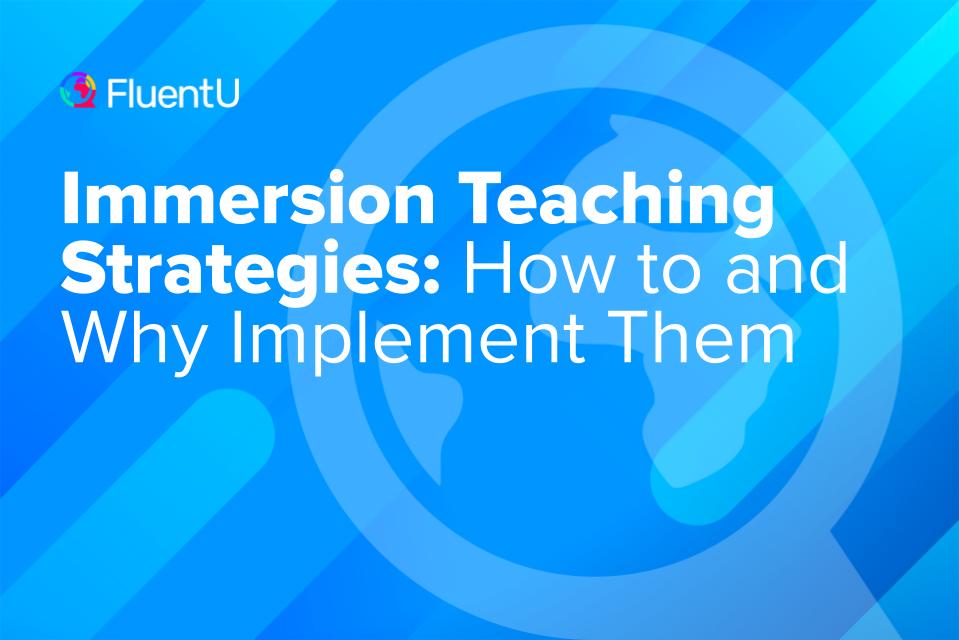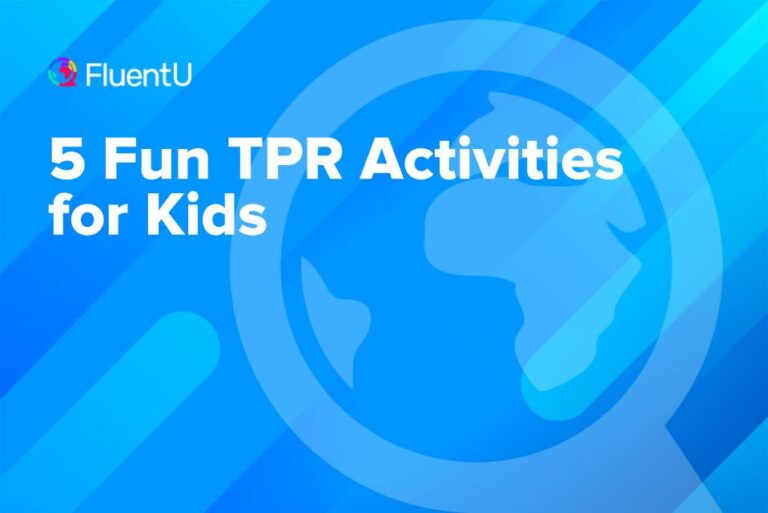Contents
- What is Immersion Teaching?
- Fun Immersion Teaching Strategies
- 1. Provide a structured learning environment
- 2. Use visuals for comprehensible input
- 3. Use gestures and tones
- 4. Use stacking to repeat lessons without being repetitive
- 5. Let technology and multimedia take center stage
- 6. Use culture as a jumping-off point
- 7. Use the familiar to incorporate new concepts
- 8. Focus on communication, not on language
- 9. Provide feedback and encouragement throughout the session
- Immersion Teaching Examples for Subject Classes
- The Pillars of Immersion Teaching
- How to Create an Effective Immersion Curriculum
- Benefits of Using Immersion Teaching Strategies
Immersion Teaching Strategies: How to and Why Implement Them

Are you looking for more effective ways to help your students reach fluency in a foreign language? Maybe you’re in search of a fun, engaging method that’ll deliver the results you want. Or perhaps your school is considering an immersion curriculum for its students, but you’re not sure how to make the leap.
Read on for everything you need to know to turn your school into a larger-than-life language lab with immersion teaching.
Download: This blog post is available as a convenient and portable PDF that you can take anywhere. Click here to get a copy. (Download)
What is Immersion Teaching?
Imagine transporting your whole school to a country where the target language is spoken, so your students can learn the language at a much faster pace and discover the richness of another culture.
That’s what immersion teaching is about—without actually moving anyone anywhere.
Immersion teaching is based on a simple concept: If you can’t actually be in a country where the language is spoken, you should make your learning environment as authentic as possible by “immersing” your students in as much of the language and culture as possible.
Modern immersion teaching takes advantage of all the technology we have at our disposal. After all, technology allows you to source and stage a wide range of situations so your students receive constant, ongoing exposure to the language they’re learning.
It recreates the immersive experience you’d naturally encounter if you were living in the target region full-time. This will enable your students to gain familiarity with the target language’s unique sounds and pronunciations. They’ll also get a chance to pick up more subtle non-verbal elements, social etiquette and codes. Most importantly, they’ll be placed in situations where they’ll use the language more readily and immediately.
That’s because the real virtue of immersion teaching is that it breaks down the barrier to language learning. It works by making language not the object of teaching, but the medium. Concretely, rather than teaching students how the language they’re studying works, you’ll be putting them in a context where they’ll be naturally using the language to communicate.
Fun Immersion Teaching Strategies
1. Provide a structured learning environment
Structure is key to helping your students assimilate the immersion curriculum.
During an immersion lesson, a lot of concepts, vocabulary and content will be introduced at the same time. To help students learn all this, make it simple for them to understand and memorize everything.
Students can often become overwhelmed when presented with overly-long lectures, reading assignments and demonstrations. There’s just too much new information crammed in there, and they need both time and support to learn everything from vocabulary and grammar to subject lessons.
To avoid this, keep it simple with things like:
- Bullet points: Present the essential information in bullet points, rather than narrating everything at length. Accompany every new factoid with an example to illustrate your point.
- Recap worksheets: Create recap worksheets that summarize a whole chapter or unit, and hand them out at the beginning of the lessons covering these chapters or units.
- Keywords: Write down important keywords on the board as you go over a concept. Summarize all important information, and use bullet points, lists, grids and graphs to keep things neatly structured whenever possible. PowerPoint is a great tool for creating easy-to-follow presentations on lesson content, and you can always skip back to the last slide if the class isn’t following.
2. Use visuals for comprehensible input
A big issue in teaching foreign languages is “comprehensible input.” Comprehensible input is described as using material that’s one step higher than your students’ present language proficiency levels.
So for intermediate learners, for example, you should give them materials that are “high intermediate.” You want to give them something just challenging enough, yet still within reach. If the material is too easy or difficult, your students will get bored or discouraged.
One of the most effective ways to ensure comprehensible input is by using visuals—things like pictures, videos, actual objects or manipulatives and realia.
For example, instead of using a hundred Spanish words to explain what a garden is, and describing how beautiful it is, you simply show them a picture of a beautiful garden, point to it and say, “Jardín!”
By employing things that they can see, touch or interact with, you ensure that lessons are comprehensible and memorable for your students.
So, don’t neglect the following tools when teaching immersion-based classes:
- Signs and posters: Include oversized typography, colors and images to make key concepts and vocabulary pop.
- Real-life objects: Demonstrate a concept in action with actual products or puppets.
- Charts: Condense information and use different types of charts to show the relationships between different elements.
- Ads and posters: Put large, educational signs and images around your classroom—or your entire school—that students can learn from while sitting or wandering around. This serves to increase overall familiarity with the language.
- Movies: Combine the power of visuals and sound, and get students excited about learning with fun content. Students typically learn best when there’s a combination of audio and visual content.
3. Use gestures and tones
Visual aids, realia and manipulatives are employed by practically all teaching approaches, more so by immersion teaching. But they do come at the cost of heavy preparation on the part of the teacher.
And sometimes, there’s just no perfect visual that encapsulates the concept you want to convey. So what’s an immersion teacher to do?
- Set the tone of the class by expressing your attitude through body language. For example, when describing a positive event in world history, express your excitement with your expressions and movements. Show students some gestures used by native speakers of the target language to demonstrate how every culture uses hands and non-verbal elements differently.
- Use proper gestures, body language and exaggerated voice. These are effective ways of ensuring comprehensible input. Since only the target language is used in the class, and you can’t always point to an image or object, an immersion teacher has to master how to convey meaning through voice and actions.
- Go beyond hand gestures and voices. Eye movements, body orientation, the way you tilt your head and even the rise and fall of your chest can convey various emotions and messages. When doing role-playing or dialogues, you can change your voice and body language to highlight changing characters, for example.
- Engage your students. Instead of just demonstrating (and exaggerating) the Spanish saltar (jump) using a story of a kangaroo, for example, let everyone immerse themselves in the experience. Feel free to let the class hop around for a few seconds. Not only is it fun, but you’re also creating beautiful memories that students can easily associate with the new vocabulary word.
4. Use stacking to repeat lessons without being repetitive
Stacking is a teaching strategy that involves repeatedly “hitting” a language concept or word by using different examples and situations and stimulating a wide variety of senses.
If you want to teach greetings to your students, for example, you can incorporate these in different points of your lesson. You can:
- Do greetings while telling a story. Let the characters greet each other in your story. In a role-playing situation, you can coach the students to greet each other first before they move on to their spiels.
- Show a video clip of strangers meeting each other. Ideally, the greetings should be said under different scenarios so your students can easily parse out which greeting is appropriate in which scenario.
- Make a game out of it. Think of this as a quiz—except a little more fun. Make sure you tailor the game according to your students’ level.
5. Let technology and multimedia take center stage
Technology has always been utilized for education—from yesterday’s chalkboards and slide projectors to today’s fully integrated classroom computer systems.
Used properly, technology can take you and your class anywhere you want to go. A teacher’s willingness to utilize current technologies can only mean good things for their students.
Here are a couple of examples of modern classroom technology:
- Languagenut is a teaching tool created by seasoned educators for language teachers like you. Your students can use their tablets, smartphones or laptops to play interactive language games, sing songs, listen to stories or learn vocabulary.
You can also have a tool to help you visually see how a student is doing vis-à-vis the others. Languagenut allows you to give instantaneous feedback, even outside the classroom, so it can be a valuable addition to your teaching arsenal.
- FluentU is a language teaching program with many features that’ll allow your students to absorb immersive material more readily.
For example, the interactive subtitles on the foreign language media clips allow pupils to click on any word and look up tips on how it’s used, example sentences, etc. Videos can be assigned as homework and followed up with quizzes, while you can check their progress on the teacher dashboard.
6. Use culture as a jumping-off point
Culture is what your students experience when they’re participating in an actual in-country immersion program.
They don’t learn grammar. They learn about people and begin to appreciate their way of looking at the world. And along the way, they learn about language naturally and organically.
Language learning is interdisciplinary and has a broad range of possible topics that can be explored. In culture, you can find a treasure trove of vocabulary words, word usage, nuances and idioms.
Examples of bits of culture you can use in language learning include:
- Recipes: For example, when your English students learn about American cooking or its culinary traditions, they can’t help but learn the language—more effectively so, because you’ll have given them memory-friendly context.
Aside from terms like “grilling,” “egg yolk” or “overcooked,” you can also teach expressions like “too much (salt),” “just right” and “wait for it (to boil)” that can easily be used in normal conversations.
- History, pop culture or recent politics/events: Your lesson might involve a short French article on the recent right-wing nationalist movements in Europe, for instance. Because there’s a story or issue that ties it all together, your students can easily recall valuable language pointers thanks to the story providing an anchor in their memories.
7. Use the familiar to incorporate new concepts
When only the target language is used in class, there will always be words, phrases or sentences that go over your students’ heads. This is normal.
In immersion teaching, you encourage students to work with the language and figure out meaning. In a classroom setting, you help students cope with ambiguity by providing them with some familiar concepts.
Every lesson will always have a hint of the familiar and an introduction to new concepts. This is what really happens to young native speakers as they interact with adults. They continually figure out the language, using the familiar as anchor points.
Examples of the familiar include:
- Objects: Let’s say today’s lesson is about phrases and words that convey ownership or possession. You want to use objects your students already know and understand as examples. If your Italian students already know what casa (house) or cane (dog) means, then you can use these objects as jumping-off points, as examples for your cause—like la mia casa (my house) or il mio cane (my dog).
- Reading materials: A single postage stamp can provide a whole afternoon of lessons in history. A “Roommate Wanted” posting or advertisement can teach multiple lessons on simple sentence construction. A menu can show more than just food. Writings on packages or wrappers can show not just the calorie count, but also give you a free advanced vocabulary lesson.
8. Focus on communication, not on language
Immersion teaching emphasizes the communicative nature of language.
When you do that, you stop thinking of language as different “parts of speech” divided into nouns, verbs and adjectives. You begin to zero in on tasks and situations that allow the use and display of a language.
When choosing tasks or situations for your class, it’s important to make them relevant. You could then ask your students to role-play them in class.
For example, you can:
- Have them talk about a given situation. Choose something like a simple problem or give recommendations to a friend. A student pair might discuss the recent problems they’ve had with their smartphones or music recommendations on Spotify.
- Do mock variety shows. These can involve skits and songs in the target language.
- Make it fun! Ask them to tell a joke, share what happened last weekend or relay what the pastor in church preached about.
9. Provide feedback and encouragement throughout the session
As an immersion teacher, you’re throwing things at your students that understandably unnerve them. You’re essentially putting them in situations where there’s a strong possibility of embarrassing themselves in front of their classmates (and native speakers).
So, dare your students to make mistakes. Correct them if necessary, but do it in a way that makes them feel that you have their back.
Feedback is a vital component of student performance. The amount and timing of it is important. Students who receive lots of feedback will perform better—and even more so when the feedback is delivered as soon as possible.
It’s important that the feedback be constructive—i.e., it should emphasize what the student got right, and if the student makes a mistake, a gentle correction should be given instead of simply pointing out what the student got wrong.
Also, when your students are making any sort of progress, you can:
- Give them rewards to validate their effort and progress. They don’t have to be expensive or big. Your students will appreciate any positive gestures that come their way. Rewards will make them feel appreciated, showing that you’ve noticed their effort and hard work.
- Give your gifts a cultural flavor. Yes, the rewards themselves can be educational! For example, a popular novel (written in the target language), a cult movie that epitomizes an associated culture, a poster of famous personalities who speak the language or foods from a particular region where the language is spoken.
- Set up celebration times where students can learn in a festive atmosphere. This is a positive and memorable way to bring them closer to the culture of the country in question and give them something they’ll look forward to. It’s also a terrific way to celebrate their bilingual and bicultural education.
The ideal way to plan this is to model your calendar after that of a country where the target language is spoken. Then you can celebrate all the major holidays and occasions along with native speakers around the world.
Immersion Teaching Examples for Subject Classes
Language isn’t taught in a vacuum—especially if you’re using an immersive approach!
If you believe your immersion teaching strategies could benefit from some outside help, you can ask other teachers who are part of a school-wide immersion program in subjects like the following.
Physical education
Playing sports is a terrific way to bring your students closer to the language they’re studying because it combines movement, fun and competitive spirit.
Better yet, it places the focus on physical activity rather than language, making it less likely that your students feel like they’re “on the line” with the target language.
This means that they’ll be more willing to communicate with each other in the target language, even if they’re self-conscious about their mistakes. Things move fast on the playing field and students tend to place their desire to win above everything else.
The typical strategy for leading gym classes in an immersion environment is:
- Explain the rules of the game or sport in the target language. Check if anyone has questions.
- If any speaking is required, make sure students know the right words and phrases. Even if they don’t need to speak, teach your students some fun exclamations they can shout out when exciting things happen in the game.
- Play the game or sport. This allows your students to demonstrate their comprehension of the rules in the target language.
History
A strong storytelling component can fast-track your students’ knowledge of the language and culture(s) they’re studying via immersion.
History teachers can make a profound difference in a school immersion program, and language teachers who integrate history lessons into their classes also have this power.
Aside from teaching them about the roots of the language, history gives students a framework to think and understand current events and challenges.
One cool way to bring history to your immersion classroom is to have students create their own historical timeline.
Along with historical facts about the target country or civilization, they’ll learn plenty of useful vocabulary that applies to social sciences, including political, economic, social and cultural words. They’ll also solidify their knowledge of past tenses, along with numbers, locations and names of famous people.
Here’s how your students can create their historical timelines:
- Learn more about specific periods before assigning tasks. Have them read the country’s Wikipedia page for a brief overview of the main events that occurred in this country. Alternatively, subscribe to CountryReports for concise insights about a variety of countries.
- Split into small teams. Two or three students per group is ideal, depending on how many there are. Assign each team a time period for a particular region. Assigning a team a whole century may not make sense—the workload between teams might not be even considering that some centuries are less eventful than others.
- Conduct further research. Now, ask students to identify key events, figures, inventions, publications, works of art and anything else that seems important. Let them create their own timeline on a poster, encouraging them to use colors, pictures and other visual elements. Set up with a color code for everyone: Black ink for politics and events, green for economics, red for battles, blue for arts and so on.
- Assemble posters in order. With all the timelines created, put the posters together in chronological order, next to one another, on a wall in your classroom. You’ll then have a beautiful, larger-than-life timeline.
Science
Some students learn best through experimentation, not theoretical studies.
That’s where science experiments come in.
They provide a terrific opportunity to develop scientific vocabulary while also introducing key theories, concepts and processes.
For example, you can have students:
- Build a volcano (or something similar). Not only is it fun, it’s also incredibly memorable, thrilling, inexpensive and easy to execute in class. For volcanoes, follow these WikiHow instructions to get acquainted with the process.
You’ll notice there are numerous ways to build these from scratch. Choose the one that works best for you—that is, achievable within your desired time frame and uses elements your school already has available.
- Go over the process with your students. This is a good opportunity to introduce them to the vocabulary of the scientific method. To teach all of this, draw a chart on the board and ask students to follow the steps in the scientific method, but in the target language:
- Ask a question
- Formulate hypotheses
- Develop testable predictions
- Execute the experiment
- Gather and analyze data
- Provide a discussion and a conclusion.
- Supervise all science experiments and teach your students laboratory safety rules first. Otherwise, the whole endeavor will be memorable for the wrong reasons!
If you’re looking for other cool experiment ideas, head over to this resource page on Science Kids. This will give you a general idea of what you can do, even though you’ll have to have to ensure you’ve got all the vocabulary perfectly translated into the target language.
Lunch time
No, lunch isn’t exactly a subject—even if some of us wish it were.
The important thing to know is that learning doesn’t stop in the classroom.
Turning your school cafeteria into a 100% target-language zone is a fantastic way to help the whole student body improve their fluency without much effort. That’s because they’ll be in situations where they’ll practice small talk in a friendly, relaxed atmosphere.
You can:
- Have lunches with authentic foods from places where the target language is spoken. Bringing these flavors into your school cafeteria may not be an option every day, but with one special lunch per week, you’ll still introduce the spirit of the language and its related cuisine to the cafeteria.
- Hang posters and pictures of famous dishes (with the school’s/cafeteria’s permission). Make sure they include the names of the dishes and lists of main ingredients.
- Have the cafeteria staff add a unique target-language word or phrase to their name tags. This is a nice, personal touch, as you can ask them to choose an adjective that best describes their personality, their favorite vegetable or their favorite city where the target language is spoken.
- Display menus and food labels in the target language. Even better, use the target language for food that actually comes from the country where that language is used.
- If possible, make sure the interactions with the cafeteria staff will be in the target language only. Doing this will allow your students to practice everyday communication, simple questions, food vocabulary and social etiquette. Of course, this should only be done if the staff are actually fluent or comfortable in the target language.
Library
Your school library is a fantastic gateway to immersion teaching.
Authentic books, dictionaries, magazines, movies and audiobooks in the target language can bring your students closer to the language. Better yet, a library period is often a time for introspection and quiet individual study, which allows your students to focus and reflect.
But why not make the library even more inviting?
A great way to do this is to set weekly reading sessions. Here are the steps to do this:
- Pick a book of your choice, preferably a short, age-appropriate novel or story that’s well-known in the target language. Go over the storyline, introduce the characters and mention potentially difficult words in your teaser. Don’t tell the whole story, just give students enough elements to get them excited. You want them to be eager to read and find out what happens!
- Gather students in a circle and pass the book around. Have a student read one portion aloud—be it a sentence, paragraph or page, as long as it’s manageable. Then have that student pass the book to their neighbor to continue reading out loud.
Let them read at their own pace and incorporate their personality into their reading. Some students may be more “serious,” while others are more expressive. There’s no right or wrong!
Aside from strengthening your students’ reading and storytelling skills, this will teach numerous vocabulary words along with proper spelling. Reading on a regular basis is a fantastic way to help your students visualize and remember how words are written.
The Pillars of Immersion Teaching
For immersion teaching to hit the right notes, remember these three pillars of immersion teaching: The use of authentic materials, emphasis on communication over language and the interdisciplinary nature of language learning.
Use of authentic materials
First and foremost, immersion teaching is all about using authentic materials.
Simply put, these materials are what your students will find if they get on a plane and go to the country where the target language is used. That includes newspapers, TV shows, radio programs, books and other materials native speakers use in their day-to-day lives.
Something as simple as an identification card, like this Italian ID, can be a vehicle to teach concepts and vocabulary pertaining to gender, address, age and other personal information.
There’s no limit to the kinds of authentic materials you can bring to the classroom (unless they’re illegal for any reason, of course).
Note that these kinds of materials were not actually designed to teach language. Those who use and consume them typically already have a working knowledge of the language. Authentic materials are the conduits through which native speakers communicate with each other. Since we’re on that topic, let’s move on to the next pillar.
Emphasis on communication over language
With immersion teaching, your primary objective is to prepare your students to effectively communicate in the target language.
You want to provide your students with a myriad of situations that display the use of the target language.
You’re not just talking about the language and describing its rules and forms—you’re actually using it and encouraging your students to apply it in a way that matches native speakers as closely as possible.
That’s why in immersion teaching, only the target language is used as the medium of instruction. The challenge here is to make yourself understandable to your students in the target language. We discussed some of the ways you can do exactly that in the nine strategies above.
To be truly immersive, you must also require your students to address you only in the target language. At the same time, you should be encouraging them, meaning that if they make any mistakes, you should offer gentle yet constructive criticism.
You should also provide your students with loads of opportunities to use the target language through task-oriented activities (e.g., role-playing). Such things focus on the communicative aspects of the language. It drives home to your students that “Mandarin,” for example, isn’t just a subject to be studied in school, but a way of sending (and receiving) meaningful messages.
The interdisciplinary nature of language learning
Language learning based on immersion doesn’t happen in a vacuum.
There’s less emphasis on discussing various subjects simply in the context of teaching grammar or syntax, and more on talking about these topics for their own sake in the target language.
By discussing pop culture, sports, world events, movies and the like with your students (which have their constituent vocabularies, terms and phrases that make the language come to life), you’re allowing these topics to provide the necessary context that makes the language stick in your students’ memories.
In other words, to make immersion teaching a reality, your best bet is to rethink your curriculum and integrate lessons about the language and associated cultures—even if you’re teaching math, science, history, art or gym class.
How to Create an Effective Immersion Curriculum
Let’s dive into the steps to building an immersion curriculum that supports your complete vision for your language program. This is how you set yourself up to successfully implement the teaching strategies from earlier.
Formulate a mission and vision for your language program.
Before you build your curriculum, you need a clear picture of your final destination. You can articulate that in a clear mission and vision statement that thoroughly explains why your program exists and what you hope to accomplish.
If this step leaves you feeling stuck, here are some concrete tips to homing in on your mission and vision:
- Refer to your school’s mission/vision statement. If your school has a mission and/or vision statement, this will help you clearly articulate what your program’s role is within the larger community of the school.
Your program can reflect some of the ideas in the broader mission and vision statement while making them truly your own and contextualizing them under language learning.
- Familiarize yourself with any local or state standards for language learning. Take a look at the ACTFL’s (American Council on the Teaching of Foreign Languages) World-readiness Standards for Learning Languages to find out what students in the US are expected to know and be able to do to demonstrate language proficiency.
Your state or region may also have a set of standards for language learning which can inform your decision about what your final goals should be.
- Survey the community to gauge local resources or partners. It’s possible there are native speakers in your area that you don’t even know about. Retired language teachers and professors are a potentially untapped resource. The resources available to you for immersion teaching should be part of the larger picture when planning your program.
- Find out what access students have outside the classroom to language learning. Can students get any authentic language practice at home? Do their parents or siblings know the target language? Do they have access to language apps on their tablets or mobile devices? Take this into consideration when determining a direction for your program.
- Use “backward design” to articulate the results you want. In the “backward design” model, teachers start their planning with the long-term learning goal and design short-term goals, activities and assessments around those. How will students have changed as a result of achieving the goals? What skills will they have acquired? How will they demonstrate their knowledge?
Take an inventory of resources available to you.
Once you’ve crafted the perfect mission and vision statement, the next piece to put in place is that of your resources. Hopefully, you’ve already done a preliminary survey of resources available to you, and now you just need to prepare to access them. Here’s how:
- Reach out to potential partners and helpers. Are there experts who might share your goals? What about area college students majoring in the target language? Do you have any personal connections through Facebook or Skype who could add something to your projected immersion experience?
Perhaps you could even invite a guest teacher from abroad to come visit. For example, you may be able to find an organization that facilitates teacher exchanges between countries, depending on the language.
- Communicate with subject area teachers about your goals. One of the most effective ways to incorporate immersion is by using it in subject-area classrooms. Get your coworkers on board. Educate them about the value of immersion learning and find ways to work together.
- Reach out to other schools in your area or district. Chances are, there’s a language teacher near you already using an immersion curriculum with great success. Connect with them so you can discuss what’s worked well and what hasn’t. You might even consider observing their classroom.
- Collect relevant digital materials. Software, apps and websites are key components of the curriculum in the digital age. Examples of popular online language materials that are readily available and easy to use include Duolingo, WordReference and Memrise. As with traditional materials, gather these ahead of time so you can incorporate them into your curriculum design.
Decide which immersion model works best for your school.
There is no one right way to do immersion. Every program, school and teacher is different.
Additionally, there are several different models, such as:
- Total immersion: Students spend 100% of the school day communicating and receiving instruction in the target language.
- Partial immersion: Students spend about half their day in the target language, although this can vary.
- Two-way immersion: In this model, native-speaking students of both languages are combined in one classroom with the goal of familiarizing them with the language of the other group. This model is sometimes used in American schools where there is a large percentage of native Spanish-speaking students.
The model you choose should depend on various factors, including scheduling restrictions, student level and availability of resources.
Here’s a step-by-step process to help you determine which model suits your needs the best:
- Evaluate the pros and cons of different models. For example, total immersion is often considered a great option for younger students, but older ones may do better with a partial immersion program.
- Look at your school’s schedule. Are there blocks during the day that can be allocated to language learning? Are there subject teachers who would be willing to work with you to teach their subject in the target language? See how the existing schedule could work for you, or brainstorm ideas for shifting it to support your program.
- Learn how to integrate CLIL effectively. The best immersion experience will integrate other subjects and disciplines as much as possible, and CLIL (Content and Language Integrated Learning) is an excellent medium to make that happen.
Read up on best strategies and practices for CLIL and share them with colleagues. Work together to determine which model would best support it.
- Take into account the building of literacy skills in both languages. One frequent criticism of immersion language learning is that some students may struggle to master literacy skills. That can happen when you have students with widely varied learning styles in an immersion setting, which often emphasizes speaking above reading and writing skills.
Carefully evaluate the needs of your student population when deciding which immersion model to choose, and consider how to best address their literacy instruction.
At this point, you should now have a clear vision and goal in mind, with the resources, materials and overall structure to make it happen.
Once you’ve created the best curriculum for you, you’re free to add all the spontaneity that makes immersion language learning truly memorable, all while keeping your goals in clear view.
Benefits of Using Immersion Teaching Strategies
Now that you know the strategies and the major pillars immersion teaching is founded on, let’s take a quick look at all the benefits this teaching method has to offer.
Supports educational excellence
Research shows that students who receive immersion teaching at school quickly gain a significant edge over monolingual students.
This isn’t limited to their language skills. By developing positive thinking patterns, students can outperform their monolingual counterparts in terms of cross-cultural sensitivity, literacy and even cognitive development.
By implementing immersion teaching at school, you’ll be giving your students the tools to become creative thinkers and better problem solvers and make them more employable in the ever-more competitive global job market.
Builds a high level of comfort with the target language
Immersion teaching allows students to rethink their view of the target language by breaking all barriers to communication. That’s because language isn’t the sole focus of immersion curriculum—ideas and content are.
This is incredibly empowering to learners, especially if they’re self-conscious about their accent or grammar skills. In immersion lessons, they aren’t exclusively judged on their usage of the language.
It’s more important that they can understand things and get their ideas across. They’ll always have the opportunity to interact more freely and naturally, without fear of failing. In effect, students are more willing to engage and participate in class.
Encourages students to learn naturally
The first days of immersion are the hardest for your students, especially if they have limited knowledge of the language to start with.
Eventually, things become much easier for them, because continuous exposure to a language is key to fluency.
Even students who don’t think they’re good at learning foreign languages will find a way to learn more easily. For instance, they’ll shine in another subject—like math or art—and, since they want to learn more about something they’re passionate about, their linguistic ability will follow.
Exposes students to foreign cultures
Fluency isn’t about language alone. Their knowledge of the culture counts too.
Immersion teaching helps bridge the language and culture gaps that often pop up. It exposes your students to many aspects of cultures associated with the target language, especially ones that aren’t necessarily taught in the regular language classroom, such as pop culture, gastronomy, social etiquette and the educational system itself.
Now that you have the tools to successfully teach your target language through immersion, what are you waiting for?
Use them to make your classes seem like a walk in the streets of Paris, Tokyo, Seoul or Rome.
Apply them to make memorable lessons that will train your students to actually talk (and think!) in their target language.
Good luck!
Download: This blog post is available as a convenient and portable PDF that you can take anywhere. Click here to get a copy. (Download)













